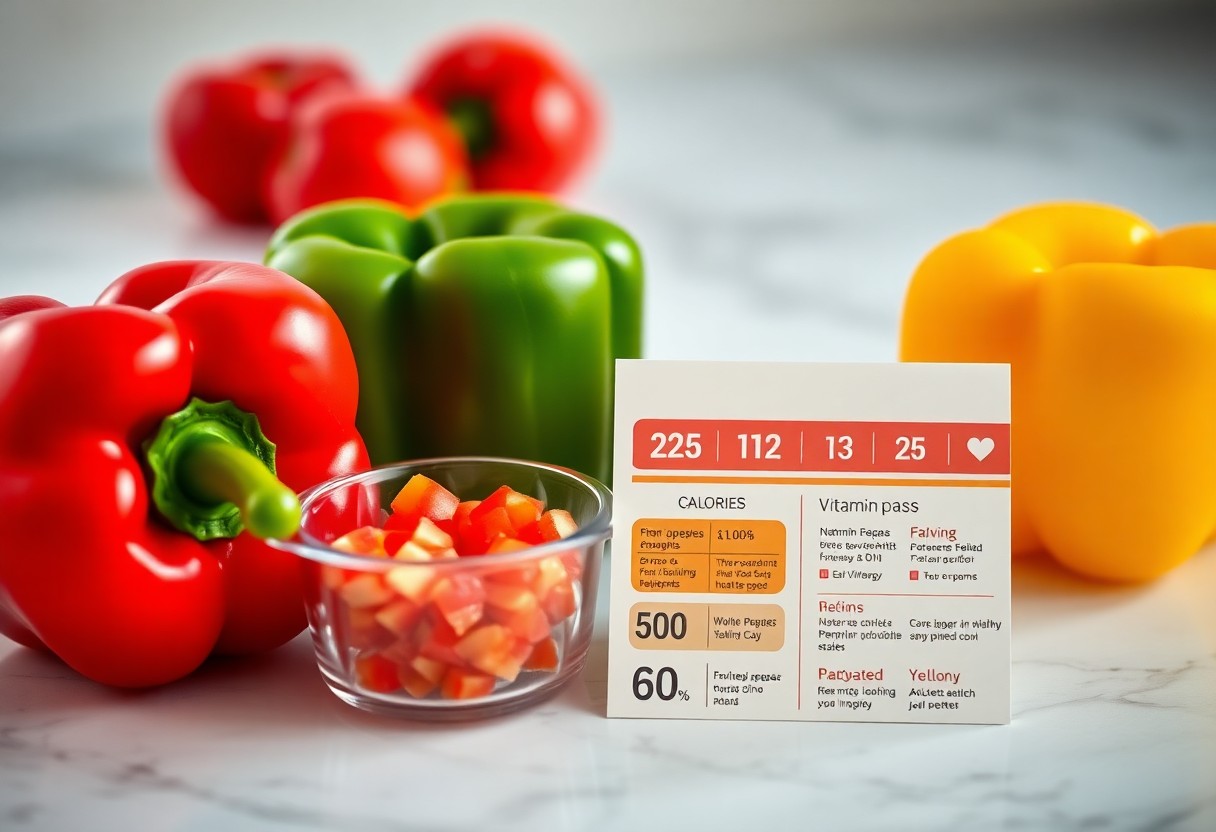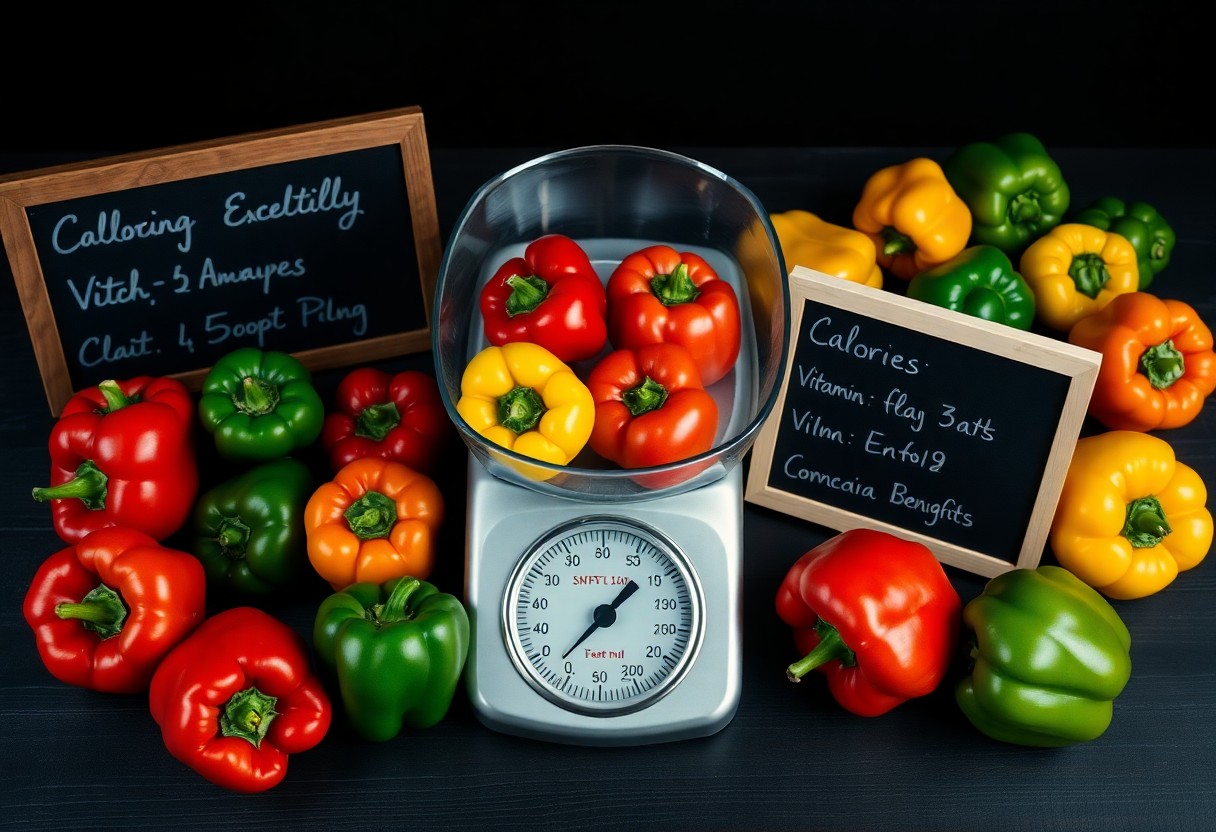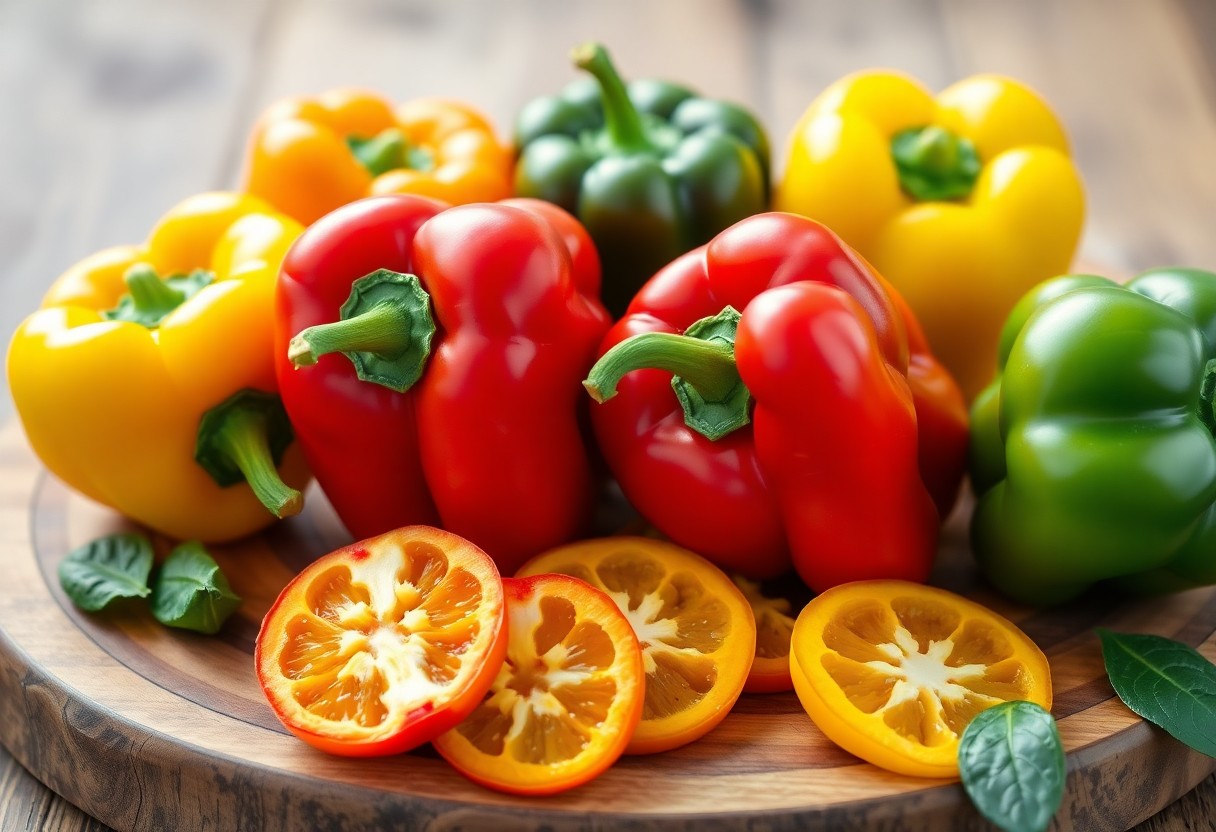Most people are unaware of the impressive nutritional profile of bell peppers, which can enhance your diet in numerous ways. Packed with necessary vitamins, minerals, and low in calories, these colorful vegetables are a powerhouse for your health. By incorporating bell peppers into your meals, you can boost your overall wellness significantly. Explore the details of their nutritional benefits further in NUTRITION AND YOU...BELL PEPPERS.

Key Takeaways:
- Bell peppers are low in calories, with approximately 30 calories per medium-sized pepper.
- They are rich in vitamins A, C, and B6, contributing to immune support and skin health.
- Including bell peppers in your diet may provide antioxidants and promote heart health.
Nutritional Profile of Bell Peppers
Bell peppers are not only vibrant and flavorful but also packed with necessary nutrients that contribute to overall health. A low-calorie option, bell peppers come in various colors, each offering slightly different nutrient profiles. Their combination of vitamins, minerals, and antioxidants makes them an excellent addition to your diet for maintaining health and wellness.
Calories and Macronutrients
One medium bell pepper contains about 25 calories, making it a low-energy-density food. The macronutrient breakdown includes approximately 1 gram of protein, 6 grams of carbohydrates, and negligible fat. This makes bell peppers an ideal snack or ingredient for those looking to manage their weight without sacrificing flavor.
Vitamins and Minerals
Bell peppers are rich in vitamins A, C, and K, as well as several B vitamins. One medium red bell pepper provides over 150% of your daily recommended intake of vitamin C, a powerful antioxidant that supports immune function. Additionally, they contain potassium, folate, and small amounts of magnesium and iron, contributing to various bodily functions.
The high vitamin C content in bell peppers not only enhances your immune system but also aids in collagen production, promoting skin health. Vitamin A is necessary for vision and skin integrity, found predominantly in red and yellow varieties. Moreover, the folate present in bell peppers plays a crucial role in DNA synthesis and cell division, making them a beneficial choice for pregnant individuals. Including bell peppers in your meals ensures you receive a robust array of vitamins and minerals important for your well-being.
Health Benefits of Bell Peppers
Incorporating bell peppers into your diet offers various health benefits. Rich in vitamins A and C, they boost your immune system and promote healthy skin. Their fiber content aids in digestion, while low calories make them a weight-friendly option. Eating bell peppers regularly may even reduce the risk of chronic diseases. For a comprehensive look at the specific benefits, refer to Eating Peppers: Ingredients, Benefits, and Prep Tips.
Antioxidant Properties
Bell peppers are abundant in antioxidants like flavonoids and carotenoids that combat oxidative stress in your body. These compounds help neutralize free radicals, reducing inflammation and potentially lowering the risk of chronic diseases such as heart disease and cancer.
Impact on Eye Health
Your eye health can significantly benefit from bell peppers, particularly due to their high levels of vitamins A and C. These vitamins are important for maintaining good vision and preventing conditions such as macular degeneration and cataracts.
Carotenoids, specifically lutein and zeaxanthin found in bell peppers, enhance your eye's defense against harmful blue light and oxidative damage. This protective effect, combined with a diet rich in colorful fruits and vegetables, underscores the importance of including bell peppers in your meals for long-term eye health.

Bell Peppers and Weight Management
Incorporating bell peppers into your meals can significantly aid in weight management due to their low-calorie content and nutritional density. They provide crucial vitamins and minerals without adding excessive calories, making them an ideal choice for those looking to maintain or lose weight. Their vibrant colors and crisp texture enhance meals, helping you feel satisfied while enjoying a healthy diet.
Low-Calorie Snack Options
Bell peppers serve as an excellent low-calorie snack option. You can slice them up and pair them with hummus, yogurt dip, or enjoy them raw for a crunchy treat. A medium bell pepper contains only about 24 calories, allowing you to indulge without worry. Their versatility lets you mix and match with various dips and toppings, keeping your snacking both exciting and nutritious.
Fiber Content and Satiety
The fiber content in bell peppers plays a significant role in enhancing feelings of fullness, which can help control your appetite. Each medium-sized bell pepper contains about 2.5 grams of dietary fiber, contributing to digestive health and prolonged satisfaction after meals. Including fiber-rich foods like bell peppers can be part of effective weight management strategies.
The dietary fiber in bell peppers not only aids digestion but also slows down the absorption of nutrients in your body, providing sustained energy levels. This gradual nutrient release helps manage blood sugar levels and reduces hunger pangs. By adding bell peppers to your meals, you effectively increase the volume of your food without significantly raising your caloric intake, allowing you to feel fuller for longer periods. This approach can be instrumental in achieving and maintaining your weight goals without compromising on taste or nutrition.
Culinary Uses of Bell Peppers
Bell peppers are versatile ingredients that enhance dishes with their vibrant colors and sweet, crisp texture. You can slice them raw for salads, roast them for deep flavor, or stuff them with grains, meats, or cheeses for a satisfying meal. Their mild taste allows them to pair well with various cuisines, from Mediterranean to Asian, making them a staple in your kitchen. You’ll find bell peppers in stir-fries, fajitas, or as a base for sauces, showcasing their adaptability in countless recipes.
Popular Recipes
Incorporate bell peppers into your meals with popular recipes such as stuffed bell peppers filled with quinoa and black beans or a hearty vegetable stir-fry combining multiple colors for a nutrient-packed dish. You may also enjoy roasted bell peppers drizzled with balsamic glaze as a side, or use them in a classic ratatouille for a flavorful, rustic touch. These recipes bring out the best in bell peppers, allowing you to savor their natural sweetness while enjoying their health benefits.
Storage and Preparation Tips
To maximize the freshness of bell peppers, store them in the crisper drawer of your refrigerator, unwashed, and in a perforated plastic bag. Rinse them under cold water just before use and dry thoroughly to prevent spoilage. When preparing, cut off the top and bottom, then remove the seeds and membranes for cleaner slices. For long-term storage, consider freezing sliced bell peppers, which can be added directly to cooked dishes without thawing.
- Store in the refrigerator for up to one week.
- Freeze slices for easy access in recipes.
- Wash just before use to extend shelf life.
- Thou can cut and de-seed bell peppers using a sharp knife for optimal results.
Using proper storage techniques ensures you can enjoy bell peppers at their best. Store them in a cool, dry place if you consume them within a couple of days; otherwise, opt for refrigeration. If you plan to slice and use them later, prep in advance but store slices in an airtight container. Also, consider blanching before freezing to maintain color and texture. Always inspect for any signs of spoilage before use to ensure quality.
- Check for firmness before purchase.
- Store whole for maximum freshness; cut only what you need.
- Look for glossy skin with vibrant color.
- Thou can also use bell peppers as a low-calorie snack with hummus or dip.
Comparison with Other Vegetables
| Vegetable | Calories per 100g |
|---|---|
| Bell Pepper | 20 |
| Carrot | 41 |
| Broccoli | 34 |
| Spinach | 23 |
Nutritional Advantages
Your intake of bell peppers offers a range of nutritional advantages. Compared to many other vegetables, bell peppers are low in calories but high in vitamins A and C, as well as antioxidants. A single medium bell pepper can provide more than 150% of your daily vitamin C needs, outpacing many other vegetables in terms of nutrient density.
Versatility in Diets
Incorporating bell peppers into your meals is an easy way to diversify your diet. Their sweet flavor and crunchy texture make them suitable for raw consumption in salads, while they can also be sautéed, roasted, or stuffed to enhance various dishes.
You can enjoy bell peppers in numerous culinary applications, from fresh salsas and dips to hearty stir-fries. They blend well with grains, proteins, and other vegetables, giving you the flexibility to experiment. Stuff them with quinoa or rice for a filling dish, or slice them into strips for snacking or dipping. This adaptability makes bell peppers an crucial addition to any balanced meal plan, supporting both creativity in the kitchen and nutritional needs. Their array of colors also visually enriches your plate, making healthy eating more appealing.
Final Words
The nutritional profile of bell peppers offers you a wealth of vitamins, minerals, and health benefits. With low calories and high vitamin C content, including them in your diet can contribute significantly to your overall health. Bell peppers also provide antioxidants and fiber, supporting your immune system and digestive health. By incorporating bell peppers into your meals, you not only enhance flavor but also boost your nutrient intake. Prioritizing these colorful vegetables can lead to a healthier lifestyle.
FAQ
Q: What are the calorie content and macronutrient breakdown of bell peppers?
A: A medium bell pepper (about 150 grams) contains approximately 30 calories. It provides about 0.5 grams of fat, 6 grams of carbohydrates, and 1 gram of protein. The majority of the carbohydrates come from dietary fiber, with around 2 grams per pepper.
Q: Which vitamins are found in bell peppers?
A: Bell peppers are rich in vitamins, particularly vitamin C, providing over 150% of the daily value in just one medium pepper. They also contain significant amounts of vitamin A, vitamin B6, vitamin K1, and folate.
Q: What are the health benefits of including bell peppers in my diet?
A: Eating bell peppers can enhance overall health, as they are high in antioxidants, which can reduce inflammation and lower the risk of chronic diseases. They are also beneficial for skin health, vision, and boosting the immune system due to their vitamin content.
Q: Are there any unique compounds in bell peppers that contribute to their nutritional value?
A: Yes, bell peppers contain phytochemicals such as carotenoids (like beta-carotene and lutein), which are beneficial for eye health, and flavonoids, which have antioxidant properties that may protect against various diseases.
Q: How can I incorporate bell peppers into my meals for maximum nutrition?
A: Bell peppers can be enjoyed raw in salads, grilled or roasted as a side dish, stuffed with grains and proteins, or blended into sauces and soups. Eating them raw preserves most of their nutrients, particularly vitamin C.







0 Comments